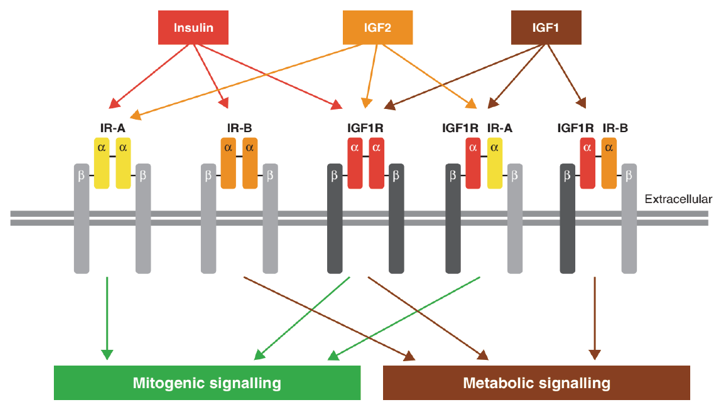
Our promise to you:
Guaranteed product quality, expert customer support.
 24x7 CUSTOMER SERVICE
24x7 CUSTOMER SERVICE
 CONTACT US TO ORDER
CONTACT US TO ORDER
IGF2 Gene Editing 
Insulin-like growth factors (IGF) play significant roles in many tumor proliferation, growth, differentiation, and angiogenesis, and are thus regarded as promising targets in cancer therapy. Mature insulin-like growth factor 2 (IGF2) is a 67 amino acid peptide produced mainly by liver, however, it is also secreted by most tissues where it can act in a paracrine or autocrine manner. Although IGF1 and IGF2 share about 70% homology in amino acid sequence, they each have their distinct functions. IGF2 signals via three receptor complexes namely the insulin receptor isoform A (IR-A), IGF1 receptor (IGF1R), and the IGF1R–IR-A hybrid receptor. IGF1R binds both IGFs with comparable and high affinity. It is thought to mediate most of the biological effects of IGF2.
 Figure 1. Ligands and receptors of the IGF system. (Livingstone C. 2013)
Figure 1. Ligands and receptors of the IGF system. (Livingstone C. 2013)
There is considerable evidence that IGF2 regulates cell growth, differentiation and metabolism. It is especially important in promoting fetal growth, being highly expressed during embryogenesis. Moreover, IGF2 expression may be deregulated by transcription factors. Functionally, IGF2 overexpression is sufficient to initiate breast tumors as well as some other malignancies in genetically engineered mouse models. Similarly, IGF2 modulates the penetrance of large T antigen-induced islet cell tumors and PTEN-deficient breast tumors, and IGF2 is essential for the formation of Ptch-deficient medulloblastoma and rhabdomyosarcoma.
Targeting IGF2 in cancer
IGF2 is an attractive therapeutic target because its apparently minor physiological role in adults indicates that ablation of its action carries little potential for disrupting normal processes. Recently, there have been exciting developments in therapies targeting IGF2. Antibody blockade inhibits mitogenic signaling through blocking ligand binding and enhancing receptor endocytosis. Simultaneous targeting of both IGF2 signaling routes has proven effective in osteosarcoma. Recent work on GIST cell lines, expressing big IGF2 and IR-A, but not IGF1R, showed that cell survival was reduced when signaling was disrupted by down-regulation of big IGF2 or IR-A. Therefore, Big IGF2/IR-A signaling is a potential therapeutic target.
Novel approaches to consider for therapeutic development include RNA interference that was shown to restore chemosensitivity in a Taxol-resistant ovarian cancer xenograft model. Targeting the key regulatory mechanisms to decrease IGF2 expression is another strategy that has the potential advantage of co-targeting additional oncofetal genes simultaneously. Alternatively, the oncofetal promoter activation of IGF2 could be exploited by therapeutic vectors designed to express toxins under the control of these promoters. For instance, a double promoter-expressing diphtheria toxin vector is in pre-clinical development and relies on the usage of P3 and P4 of IGF2 by malignant cells. Lastly, the altered expression of IGF2 transcripts and peptides by malignant cells could potentially be targeted for the development of novel cancer biomarkers.
IGF2 Gene Editing Service
CRISPR/Cas9 PlatformCB at Creative Biogene is dedicated to offering comprehensive CRISPR/Cas9 gene editing services and products for academic research, biotech research and pharmaceutical drug discovery. With deep gene editing knowledge and extensive experience in experimental operation and data processing, we help you effectively control IGF2 genes knockout/knockin/point mutation in cells or animals via CRISPR/Cas9 technology.
| Service | Details | Alternative cell lines or animal species |
| IGF2 Gene Editing Cell Line Generation |
| HEK239T, Hela, HepG2, U87, Ba/F3, CHO, MDA-MB-453, MDA-MB-231NIH3T3, T47D, Neuro2a, MCF7, RKO, K562, RAW264.7, etc. |
| IGF2 Gene Editing Animal Model Generation |
| Mouse, rat, rabbit, zebrafish, C. elegans, etc. |
Related Products and Services at CRISPR/Cas9 PlatformCB
References
- Livingstone C. IGF2 and cancer. Endocrine-related cancer, 2013, 20(6): R321-R339.
- Brouwer-Visser J, Huang G S. IGF2 signaling and regulation in cancer. Cytokine & growth factor reviews, 2015, 26(3): 371-377.
- Vidal S J, et al. A targetable GATA2-IGF2 axis confers aggressiveness in lethal prostate cancer. Cancer cell, 2015, 27(2): 223-239.
- Zanella E R, et al. IGF2 is an actionable target that identifies a distinct subpopulation of colorectal cancer patients with marginal response to anti-EGFR therapies. Science translational medicine, 2015, 7(272): 272ra12-272ra12.